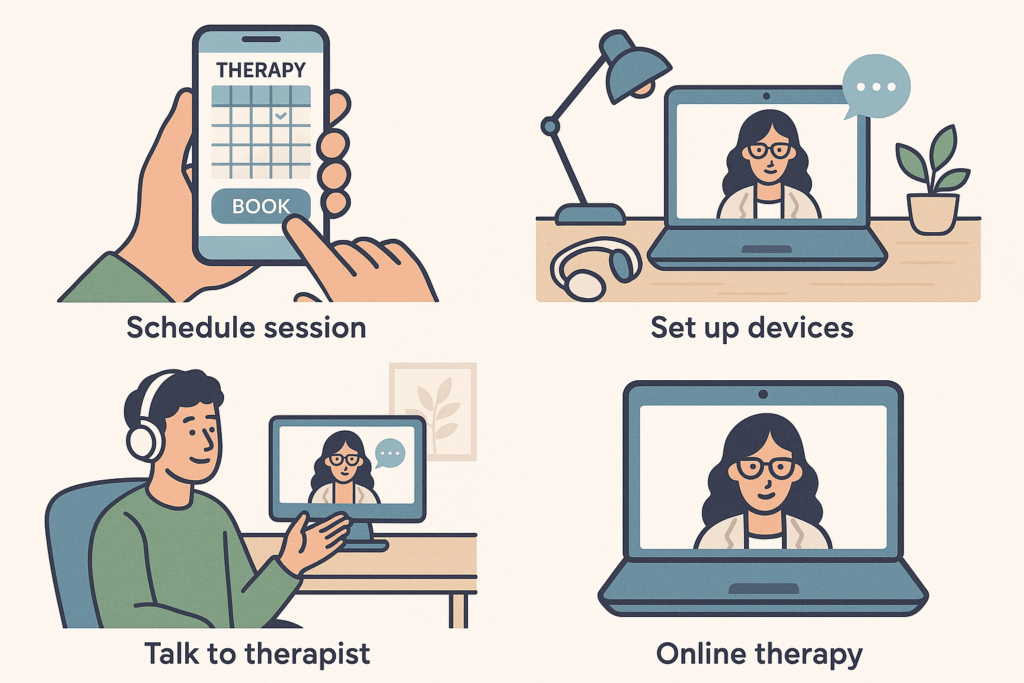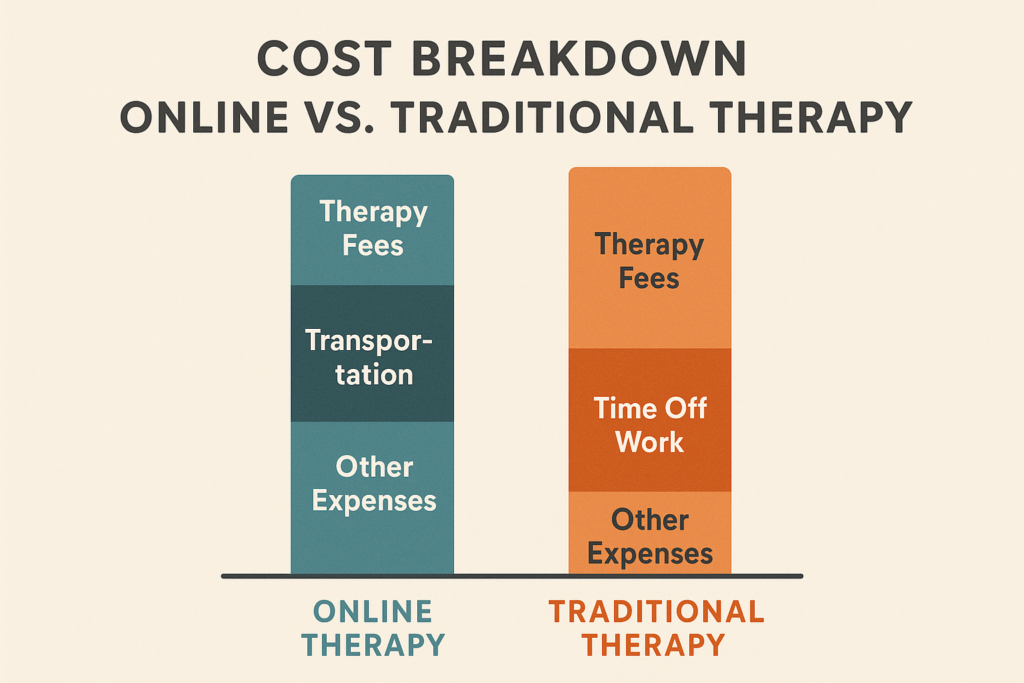Find Your Best Trauma Therapy Match in 2 Minutes
Struggling to choose between EMDR and CBT for trauma recovery? This personalized assessment helps you discover which approach might work best for your specific needs and preferences.
Trauma doesn’t wait for business hours. Online therapy for trauma is changing how millions of people heal from PTSD and traumatic stress without leaving their homes.
For trauma survivors, sitting in a therapist’s waiting room can trigger more anxiety than healing. Virtual trauma treatment eliminates this barrier completely.

You can now access professional trauma treatment from your safest space – home. Over 70% of adults have experienced trauma, yet only 15% ever receive treatment. The biggest barriers? Fear, inconvenience, and lack of access to specialists.
Digital trauma therapy removes these obstacles. No waiting rooms. No commutes. No explaining yourself to receptionists. Just effective, evidence-based treatment delivered when and where you need it most.
Here’s what you’ll learn in this guide:
- How online therapy for trauma actually works
- Which trauma treatments work best virtually
- Real costs and insurance coverage options
- How to choose the right platform
- What to expect from your first session
Let’s explore how virtual trauma treatment could transform your healing journey.
What Is Trauma and How Does Online Trauma Therapy Help?
First, let’s clear up what trauma really means. Many people think trauma only happens after major events like accidents or violence. That’s not true.
Trauma is your mind and body’s response to overwhelming stress. This includes big events and smaller, repeated stressors. Financial worry, relationship conflicts, and work stress can all create trauma responses.

Understanding Traumatic Events and Their Impact
Traumatic events fall into several categories:
Acute Trauma:
- Single incidents like accidents or attacks
- Natural disasters
- Medical emergencies
- Sudden losses
Complex Trauma:
- Repeated abuse or neglect
- Long-term domestic violence
- Childhood emotional abuse
- Extended medical treatment
Developmental Trauma:
- Early childhood disruptions
- Inconsistent caregiving
- Emotional neglect
- Frequent moves or separations
Your brain doesn’t distinguish between “big” and “small” trauma. It responds to protect you. Sometimes this protection system gets stuck in “on” mode.
Next, online trauma therapy helps reset this system. It teaches your brain that you’re safe now. The beauty of virtual treatment is that you can do this work in your actual safe space.
The Science Behind Online Therapy for Trauma
Research strongly supports virtual trauma treatment. Multiple randomized controlled trials show digital treatment works as well as in-person therapy.
A major study in the Journal of Medical Internet Research found that virtual trauma therapy reduced PTSD symptoms by 65%. Participants felt just as connected to their therapists online.
Why does virtual trauma therapy work so well?
- You control your environment
- No travel anxiety or triggers
- Easier to open up from home
- Technology feels familiar and safe
- Sessions can happen when you need them most
The key is working with trauma-trained therapists who understand virtual treatment. They know how to create safety through a screen.
Types of Online Trauma Therapy and Evidence-Based Treatments
Not all therapy approaches work the same online. Some trauma treatments adapt perfectly to virtual sessions. Others need modifications to be effective.

Cognitive Behavioral Therapy for Trauma (CBT)
Cognitive behavioral therapy is the gold standard for trauma treatment. It works exceptionally well online because much of the work involves thinking patterns and homework.
How CBT helps with traumatic stress disorder:
- Identifies trauma-related thoughts
- Challenges unhelpful beliefs
- Teaches coping skills
- Reduces avoidance behaviors
Online CBT techniques include:
- Thought records you complete between sessions
- Exposure exercises guided virtually
- Relaxation training through video
- Homework assignments delivered digitally
Research shows virtual CBT for trauma achieves similar results to in-person treatment. Many people prefer it because they can practice skills in their real environment.
Eye Movement Desensitization and Reprocessing (EMDR) Online
Eye movement desensitization might seem impossible online. Actually, many therapists successfully provide EMDR virtually using special software.
How online EMDR works:
- Therapists use apps that create bilateral stimulation
- You follow moving objects on your screen
- Audio tones can replace eye movements
- Self-administered tapping techniques work too
Studies show virtual EMDR reduces posttraumatic stress disorder symptoms effectively. The key is having an EMDR-trained therapist who knows online adaptations.
When is online EMDR recommended?
- Processing specific traumatic memories
- Reducing trauma triggers
- Healing from single-incident trauma
- Working through childhood trauma
Cognitive Processing Therapy in Digital Format
Cognitive processing therapy translates perfectly to online treatment. Much of the work involves writing about trauma, which works naturally in virtual sessions.
The process includes:
- Written trauma narratives
- Challenging trauma-related beliefs
- Understanding how trauma affects thinking
- Developing balanced perspectives
Therapists can review your writing between sessions. This provides more support than traditional weekly meetings. Many clients prefer typing their stories rather than speaking them initially.
Other Specialized Online Trauma Treatments
Trauma-focused group therapy happens successfully online too. Virtual groups offer several advantages:
- Greater anonymity and safety
- No geographic limitations
- Easier attendance from home
- Access to specialized groups
Complex PTSD online therapy often combines multiple approaches. Therapists might use CBT, EMDR, and mindfulness techniques together. For more information about our comprehensive approach, see our guide on trauma-informed therapy approaches.
Couples therapy for trauma recovery helps when trauma affects relationships. Partners can attend sessions together from home, creating a comfortable environment for difficult conversations. Learn more in our article about couples therapy for trauma recovery.
Who Can Benefit from Online Trauma Therapy Services?
Online therapy for trauma works well for many people, but it’s not right for everyone. Understanding who benefits most helps you make informed decisions.

Ideal Candidates for Virtual Trauma Treatment
You might thrive with online trauma therapy if you:
- Feel anxious about leaving home
- Live far from trauma specialists
- Have a busy or unpredictable schedule
- Prefer written communication initially
- Want to heal in your safe space
- Need flexible session timing
Adults with PTSD symptoms often prefer online treatment. The control over environment reduces anxiety about therapy itself.
Survivors of childhood trauma frequently feel safer starting virtually. They can build trust with therapists gradually before considering in-person meetings.
People with complex trauma benefit from having sessions at home. Their living space becomes part of the healing process.
When Online Therapy May Not Be Appropriate
However, online trauma therapy isn’t suitable for everyone. Some situations require in-person care:
Consider in-person therapy if you:
- Experience severe dissociation during trauma work
- Have active safety concerns or suicidal thoughts
- Struggle significantly with technology
- Need intensive daily support
- Have unstable housing situations
Severe mental health conditions requiring hospitalization need in-person assessment. Online trauma therapy works best for outpatient treatment.
Technology barriers can also make virtual therapy challenging. Reliable internet and private space are essential for effective treatment.
How Online Trauma Therapy Sessions Work
Understanding the process helps reduce anxiety about starting online therapy for trauma. Virtual sessions follow similar structures to in-person meetings, with some key differences.

What to Expect from Your First Online Trauma Therapy Session
Your first session focuses on safety and connection. Trauma therapists prioritize creating safety before processing traumatic events.
The initial session typically includes:
- Technology setup and troubleshooting
- Safety assessment and planning
- Trauma history overview
- Treatment goal setting
- Crisis protocol discussion
Building therapeutic rapport virtually takes slightly longer than in person. Your therapist will work extra hard to connect through the screen. They might use specific techniques like:
- More frequent check-ins about your comfort
- Clear explanations of what they’re observing
- Extra validation and encouragement
- Specific questions about your experience
Most people feel surprised by how connected they feel to their online therapist. The key is giving the relationship time to develop.
Ongoing Online Trauma Treatment Process
Regular trauma therapy sessions usually last 50 minutes, just like in-person meetings. The structure often includes:
Session beginning (10 minutes):
- Check-in about your week
- Review any homework or practice
- Address immediate concerns
- Set session agenda
Middle work (30 minutes):
- Processing traumatic memories
- Learning new coping skills
- Practicing techniques together
- Working through specific challenges
Session ending (10 minutes):
- Summarizing what you learned
- Planning between-session practice
- Ensuring you feel stable to end
- Scheduling next appointment
Between-session support varies by platform and therapist. Some offer messaging for questions. Others provide crisis phone lines. Most assign homework to practice new skills.
Duration and Frequency of Online Trauma Therapy
How long trauma therapy takes depends on several factors:
- Type and severity of trauma
- Your personal healing timeline
- Other mental health conditions
- Life stressors and support system
- Treatment approach used
Typical treatment timelines:
- Single trauma incidents: 12-20 sessions
- Complex trauma: 6 months to 2 years
- Childhood trauma: Often longer-term work
- PTSD symptoms: Usually improve within 3-6 months
Session frequency usually starts weekly. As you improve, sessions might spread to every other week. Some people prefer intensive work with multiple sessions weekly.
The beauty of online trauma therapy is flexibility. You can adjust frequency based on your needs and schedule.
Choosing the Best Online Trauma Therapy Platform
Not all online therapy platforms offer quality trauma treatment. Choosing the right platform makes a huge difference in your healing experience.

Essential Features for Trauma-Informed Online Therapy
Look for these critical features:
Security and Privacy:
- HIPAA-compliant platforms
- End-to-end encryption
- Secure video connections
- Protected file sharing
- Clear privacy policies
Crisis Support:
- 24/7 crisis phone lines
- Emergency protocols
- Local emergency contacts
- Safety planning tools
- Immediate response procedures
Therapist Qualifications:
- Licensed in your state
- Trauma specialization training
- Online therapy experience
- Good client reviews
- Continuing education records
Technology Features:
- Reliable video quality
- Easy scheduling system
- Secure messaging options
- File sharing capabilities
- Mobile app availability
Top Online Therapy Platforms for Trauma
Several platforms specialize in trauma treatment:
Talkspace offers trauma-focused therapists and accepts many insurance plans. Their platform includes crisis support and secure messaging.
BetterHelp has a large network of trauma specialists. They offer multiple communication options and financial aid programs.
The Empowering Space specializes in trauma therapy for millennials. They focus on anxiety, depression, and trauma with affordable options starting at $35 per week.
EMDR therapy requires specialized platforms. Some therapists use dedicated EMDR software alongside video conferencing.
Red Flags to Avoid in Online Trauma Therapy
Avoid platforms or therapists that:
- Lack proper licensing verification
- Don’t offer crisis support protocols
- Have poor security measures
- Make unrealistic treatment promises
- Push expensive packages immediately
- Don’t verify therapist credentials
- Have consistently poor reviews
Quality trauma therapy takes time. Be suspicious of anyone promising quick fixes or guaranteed results.
Cost and Insurance Coverage for Online Trauma Therapy
Understanding costs helps you budget for trauma treatment. Online therapy often costs less than in-person treatment while providing equal effectiveness.

How Much Does Online Trauma Therapy Cost?
Average pricing varies by platform and therapist level:
Weekly subscription models:
- Basic messaging therapy: $60-80 per week
- Video sessions included: $80-120 per week
- Specialized trauma therapy: $100-150 per week
Per-session pricing:
- Individual sessions: $75-125 each
- Trauma specialist sessions: $100-150 each
- EMDR sessions: $120-180 each
Factors affecting cost:
- Therapist experience and credentials
- Platform features and support
- Session frequency and length
- Additional services included
- Geographic location
The Empowering Space offers affordable options starting at $35 per week with supervised interns. Licensed therapists start at $65 per week. Learn more about our affordable therapy options.
Insurance Coverage for Online Trauma Therapy
Most major insurance plans now cover online therapy for trauma at the same rate as in-person treatment.
Commonly covered plans:
- Blue Cross Blue Shield
- Aetna
- Cigna
- United Healthcare
- Humana
- Kaiser Permanente
To verify coverage:
- Call your insurance company
- Ask about telehealth mental health benefits
- Confirm online therapy coverage
- Check if pre-authorization is needed
- Understand your copay amount
Employee Assistance Programs often include free online trauma therapy sessions. Check with your HR department about available benefits.
Affordable Online Trauma Therapy Options
If you’re uninsured or underinsured:
Sliding scale programs:
- Many platforms offer income-based pricing
- Student discounts available
- Healthcare worker benefits
- Military and veteran programs
Training clinic options:
- Supervised graduate students
- Lower cost with quality care
- University-affiliated programs
- Community mental health centers
Free resources:
- Crisis text lines for immediate help
- Support groups online
- Self-help trauma apps
- Community-based programs
HSA and FSA accounts typically cover online therapy for trauma expenses. Save receipts for tax purposes.
Effectiveness Research: Does Online Trauma Therapy Work?
The research is clear: online therapy for trauma works. Multiple studies show virtual treatment achieves results equal to in-person therapy for most trauma conditions.
Clinical Studies on Virtual PTSD Treatment
Key research findings:
A randomized controlled trial of 120 PTSD patients found online therapy reduced symptoms by 67%. Participants showed lasting improvement at 6-month follow-up.
Internet-based treatment for PTSD showed significant results in multiple studies. Patients experienced:
- Reduced intrusive thoughts
- Better sleep quality
- Decreased avoidance behaviors
- Improved daily functioning
Meta-analysis results from 15 studies confirmed virtual trauma treatment effectiveness. Digital treatment worked especially well for:
- Cognitive behavioral therapy approaches
- EMDR therapy adaptations
- Exposure therapy techniques
- Skills-based interventions
Patient Satisfaction with Online Trauma Therapy
User experience surveys consistently show high satisfaction with virtual trauma treatment:
- 85% preferred online therapy convenience
- 78% felt equally connected to their therapist
- 92% would recommend online therapy to others
- 73% continued therapy longer than planned
Completion rates for virtual trauma treatment often exceed in-person treatment. The convenience factor helps people stick with treatment longer.
Therapeutic relationship quality develops just as strongly online. Many people report feeling more open during virtual sessions.
Limitations and Considerations
Online therapy for trauma isn’t perfect. Some limitations include:
Technology challenges:
- Internet connectivity issues
- Device compatibility problems
- Privacy concerns at home
- Distraction management
Clinical limitations:
- Harder to assess body language
- Limited crisis intervention options
- Some techniques need adaptation
- Requires higher self-motivation
When combination treatment helps:
- Severe trauma may need in-person sessions occasionally
- Medication management might require in-person visits
- Crisis situations need local resources
- Some people prefer hybrid approaches
Online Trauma Therapy at The Empowering Space
The Empowering Space understands that trauma healing requires specialized care. Our online trauma therapy services are designed specifically for millennials facing modern stressors.

Our Specialized Approach to Virtual Trauma Treatment
We focus on trauma-informed care that recognizes how trauma affects every aspect of life. Our approach includes:
Evidence-based treatments:
- Cognitive behavioral therapy adapted for online delivery
- EMDR therapy using specialized virtual techniques
- Cognitive processing therapy with digital tools
- Mindfulness-based trauma interventions
Millennial-focused understanding:
- Social media trauma and comparison
- Economic stress and uncertainty
- Relationship challenges in digital age
- Career pressure and identity issues
Safety-first protocols:
- Comprehensive safety planning
- Crisis support availability
- Secure, HIPAA-compliant platforms
- Clear emergency procedures
Our therapists receive specialized training in virtual trauma treatment delivery. They understand how to create therapeutic connection through screens. Read more about our therapist qualifications and training.
Affordable and Accessible Trauma Therapy Options
We believe trauma treatment should be accessible to everyone:
Pricing options:
- Supervised interns: $35 per week
- Licensed therapists: $65-85 per week
- Insurance accepted for most major plans
- Sliding scale available for financial hardship
Flexible scheduling:
- Evening and weekend appointments
- Same-week availability for new clients
- Crisis appointment slots
- Vacation and sick time accommodations
Quick start process:
- Free 15-minute consultation
- Therapist matching within 48 hours
- First appointment within one week
- 24-hour response guarantee
Integration with Comprehensive Mental Health Services
Trauma rarely exists in isolation. We offer integrated care addressing related conditions:
Additional services:
- Couples therapy for trauma’s relationship impact (learn more about our couples services)
- Group therapy for peer support
- Anxiety and depression treatment (explore our anxiety treatment options)
- Medication management coordination
Coordinated care:
- Communication with primary care doctors
- Referrals to specialists when needed
- Crisis intervention planning
- Insurance navigation support
Our team approach ensures you get comprehensive support for all aspects of trauma recovery.
Getting Started with Online Trauma Therapy
Taking the first step toward trauma healing feels scary. Online trauma therapy makes it easier by letting you start from your safe space.

Preparing for Your First Online Trauma Therapy Session
Technology setup:
- Test your internet connection speed
- Download required apps or software
- Check camera and microphone quality
- Find a private, comfortable space
- Ensure good lighting for video calls
Emotional preparation:
- Expect to feel nervous initially
- Remember healing takes time
- Prepare basic trauma history overview
- Think about your treatment goals
- Plan self-care after the session
Practical considerations:
- Block off extra time for technical issues
- Silence phone notifications
- Have tissues and water nearby
- Inform household members about privacy needs
- Wear comfortable clothing
Building a Strong Therapeutic Relationship Online
Virtual relationships develop differently than in-person connections. Here’s how to strengthen your therapeutic bond:
Communication strategies:
- Be explicit about your feelings and reactions
- Ask questions when things aren’t clear
- Share what you observe about therapy progress
- Give feedback about what’s working
Trust-building techniques:
- Allow time for connection to develop
- Be patient with technology glitches
- Focus on your therapist’s consistency and care
- Remember that healing happens gradually
Maximizing effectiveness:
- Complete between-session assignments
- Practice new skills in real situations
- Keep a therapy journal or notes
- Celebrate small improvements
Self-Care During Online Trauma Therapy
Trauma work is intense. Taking care of yourself between sessions helps you heal faster and more safely.
Between-session strategies:
- Use grounding techniques when triggered
- Maintain regular sleep schedules
- Stay connected with supportive people
- Engage in gentle physical activity
Creating support systems:
- Tell trusted friends about your therapy
- Join online trauma support groups
- Consider family therapy if appropriate
- Build relationships outside of trauma
Managing symptoms at home:
- Develop crisis coping plans
- Know when to contact your therapist
- Use self-soothing techniques regularly
- Monitor your mood and triggers
Frequently Asked Questions About Online Trauma Therapy
Treatment Effectiveness Questions
Is online therapy as effective as in-person therapy for trauma?
Yes, research consistently shows virtual trauma treatment achieves similar results to in-person treatment. Multiple randomized controlled trials demonstrate virtual therapy’s effectiveness for posttraumatic stress disorder and complex trauma.
Can online therapy help heal psychological trauma?
Absolutely. Virtual trauma treatment helps people process traumatic memories, develop coping skills, and reduce PTSD symptoms. The key is working with trauma-trained therapists who understand virtual treatment.
How long does trauma therapy take to work?
Most people notice some improvement within 4-6 sessions. Significant change usually occurs within 3-6 months. Complex trauma may require longer treatment. Virtual trauma treatment often progresses at similar rates to in-person treatment.
Does trauma therapy make you feel worse initially?
Some people experience temporary increases in traumatic stress symptoms when beginning therapy. This is normal and usually indicates treatment is working. Your therapist will help manage this process safely.
Practical Considerations
What technology do I need for online trauma therapy?
You need a device with camera and microphone (smartphone, tablet, or computer), reliable internet connection, and a private space. Most online therapy platforms work with basic technology.
How much does online trauma therapy cost?
Costs range from $35-150 per week depending on the platform and therapist. The Empowering Space offers affordable options starting at $35 weekly. Many insurance plans cover virtual trauma treatment. For detailed pricing information, visit our therapy pricing guide.
Does insurance cover virtual trauma treatment?
Most major insurance plans cover online therapy for trauma at the same rate as in-person therapy. Check with your insurance company about telehealth mental health benefits. For a complete guide to insurance coverage, read our article about therapy insurance coverage options.
Can I do EMDR therapy online?
Yes, many therapists successfully provide EMDR therapy online using specialized software and techniques. Virtual EMDR can be equally effective as in-person treatment.
Safety and Crisis Support
What happens if I have a crisis during online therapy?
Quality online therapy platforms have crisis protocols including 24/7 phone support, emergency contacts, and safety planning. Your therapist will create a specific crisis plan with you.
Is online trauma therapy confidential and secure?
Legitimate platforms use HIPAA-compliant security measures including encryption and secure servers. Online therapy for trauma maintains the same confidentiality standards as in-person treatment.
Can online therapists prescribe medication?
Most online therapists cannot prescribe medication, but they can coordinate with psychiatrists or primary care doctors who can. Some platforms offer integrated medication management services.
Getting Started Questions
How do I find a qualified online trauma therapist?
Look for licensed therapists with trauma specialization training. Verify credentials, read reviews, and ensure they have experience with online therapy for trauma. Platforms like The Empowering Space pre-screen therapists for quality.
What should I look for in an online therapy platform?
Essential features include HIPAA compliance, crisis support, licensed therapists, secure technology, and good customer service. Avoid platforms without proper credentials or security measures.
Can I switch from in-person to online trauma therapy?
Yes, many people successfully transition from in-person to online therapy for trauma. Your current therapist might offer virtual sessions, or you can find a new online provider.
Conclusion
Online therapy for trauma has revolutionized access to healing. You no longer need to choose between getting help and feeling safe. Virtual trauma treatment brings professional support directly to your comfort zone.
The research proves online trauma therapy works. People achieve the same healing outcomes as in-person treatment while enjoying greater convenience and accessibility.
Whether you’re dealing with recent trauma or childhood wounds, online therapy for trauma offers hope. You can process painful memories, develop coping skills, and reclaim your life from your own safe space.
The Empowering Space understands trauma’s complexity. Our specialized online therapy for trauma services provide affordable, effective treatment designed for modern life.
Your healing journey can start today. Don’t let trauma control your life any longer. Online therapy for trauma makes professional help accessible when you’re ready.
Ready to begin healing? The Empowering Space offers free consultations to help you determine if online therapy for trauma is right for you. Take the first step toward reclaiming your life from trauma’s grip.
Remember: Healing happens one session at a time. You deserve support that works with your life, not against it.
Find Your Best Trauma Therapy Match in 2 Minutes
Struggling to choose between EMDR and CBT for trauma recovery? This personalized assessment helps you discover which approach might work best for your specific needs and preferences.





